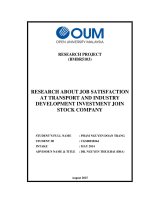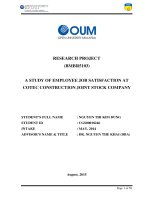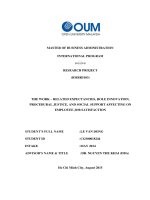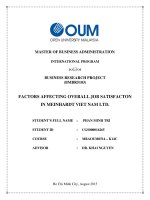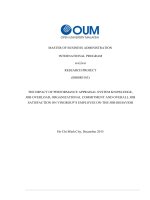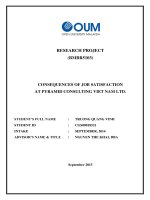Research about overall job satisfaction at tuong an vegetable oil corporation (TAC)
Bạn đang xem bản rút gọn của tài liệu. Xem và tải ngay bản đầy đủ của tài liệu tại đây (1.7 MB, 60 trang )
MASTER OF BUSINESS ADMINISTRATION
INTERNATIONAL PROGRAM
RESEARCH PROJECT
(BMBR5103)
RESEARCH ABOUT
OVERALL JOB SATISFACTION
at Tuong An Vegetable Oil Corporation (TAC)
STUDENT’S FULL NAME
: DAO MAI THAO
STUDENT ID
: CGS00019380
INTAKE
: MARCH 2015
ADVISOR’S NAME & TITLE
: NGUYEN THE KHAI (DBA)
AUGUST, 2016
STUDENT ID
: CGS00019380
ADVISOR’S ASSESSMENT
..…………………………………………………………………………………………………………
..…………………………………………………………………………………………………………
..…………………………………………………………………………………………………………
..…………………………………………………………………………………………………………
..…………………………………………………………………………………………………………
..…………………………………………………………………………………………………………
..…………………………………………………………………………………………………………
..…………………………………………………………………………………………………………
..…………………………………………………………………………………………………………
..…………………………………………………………………………………………………………
..…………………………………………………………………………………………………………
..…………………………………………………………………………………………………………
ADVISOR’S SIGNATURE
..…………………………………………………………………………………………………………
(July 2016)
..…………………………………………………………………………………………………………
..…………………………………………………………………………………………………………
..…………………………………………………………………………………………………………
NGUYEN THE KHAI (DBA)
ACKNOWLEDGMENTS
First of all, I am very grateful to my advisor DBA. Khai Nguyen for his supervision,
and constant guidance in this report.
Thank you for all suggestions have been received from many of my lecturer and
classmate during research progress.
In addition, we also would like to say thanks to all my class mates, team members,
colleagues who provided information, sharing and comments for our group
presentation during this fantastic course.
Once again, I thank very much to all.
Dao Mai Thao Student
CONTENTS
PART ONE
ABSTRACT
1
INTRODUCTION
2
1
About Tuong An Company
2
2
Organization structure and Corporate culture
7
3
Research problem statement
10
4
Research objective
10
5
Research scope
10
6
Significance of research
11
7
Limitation of research
11
PART TWO
1
LITERATURE REVIEW
12
Definition of Constructs
12
Overall Job Satisfaction
12
Work Control
13
Satisfaction with Work Schedule Flexiblity
15
Developmental Experiences
16
Satisfaction with My Supervisor
17
2
Theories of Overall Job Satisfaction
17
3
Hypotheses
25
4
Research model
26
PART THREE
1
2
METHODS
26
Data collection
26
Design template scale
26
Data collection progress
32
Data analysis
33
PART FOUR
1
2
3
PART FIVE
RESULTS
33
Cronbach’s Alpha
33
Cronbach’s Alpha standard applied
33
Cronbach’s Alpha of constructs
34
Statistics information
35
Descriptive statistics
35
Correlation statistics
36
Hypotheses testing
37
Hypothesis proposed (H1)
37
Hypothesis proposed (H2)
38
Hypothesis proposed (H3)
38
Hypothesis proposed (H4)
39
CONCLUSIONS
40
1
Discussion
40
2
Limitation of research
41
REFERENCES
41
43
APPENDIX
Appendix 1: Survey
43
Appendix 2: Presentation
50
FIGURE & TABLE
FIGURE
Figure 1
Maslow's hierarchy of needs
18
Figure 2
Alderfer’s ERG theory
19
Figure 3
Hackman and Oldham's Job Characteristics
22
Figure 4
Vroom’s Expectancy Theory of Motivation
25
Figure 5
Research model of Job Satisfaction
26
Table 1
Overall Job Satisfaction Scale
27
Table 2
Work Control
Table 3
Satisfaction With Work Schedule Flexibility Scale
29
Table 4
Developmental Experiences Scale
30
Table 5
Satisfaction with My Supervisor Scale
31
Table 6
Time table for data collection progress
32
Table 7
Cronbach’s Alpha - Internal Consistency
33
Table 8
Cronbach’s Alpha of Job Satisfaction
34
Table 9
Cronbach’s Alpha of Work Control
34
Table 10
Cronbach’s Alpha of Satisfaction with Work Schedule
34
Table 11
Cronbach’s Alpha of Developmental Experiences
35
Table 12
Cronbach’s Alpha of Satisfaction with My Supervisor
35
Table 13
Descriptive statistics
35
Table 14
Correlation statistics
36
Table 15
Model summary of H1
37
Table 16
Coefficients of H1
37
Table 17
Model summary of H2
38
Table 18
Coefficients of H2
38
Table 19
Model summary of H3
39
Table 20
Coefficients of H3
39
Table 21
Model summary of H4
40
Table 22
Coefficients of H4
40
TABLE
Business Research Methods
P a g e 1 / 54
ABSTRACT
The purpose of this research is to explore the factors influencing job satisfaction at
TuongAn Company.
Currently, there are many companies in Vietnam, especially manufacturing companies
are very focused on the satisfaction of the employees, for the purpose of keeping and
attracting labor resources are lacking.
Data was collected through the use of standardized questionnaires. Questionnaires were
given personally to 350 managerial and non-managerial employees in TuongAn
company; there were 273 questionnaires returning, in which completely responses were
used for the statistical analysis.
The result of these surveys shall be statistically analyzed by software SPSS (copyright
of IBM). Hypotheses used this research includes five constructs: one dependent
construct (Overall Job Satisfaction) and four independent constructs (Work Control,
Satisfaction with Work Schedule Flexibility, Developmental Experiences, Satisfaction
with My Supervisor)
I hope results of this research will help managers of TuongAn have some reference angle
in human resource management to improve and increase our quality resource based on
job satisfaction of employees as well as you should have perception clearly that job
satisfaction of employees will impact to working effective.
Key words in this research: Overall Job Satisfaction, Work Control, Satisfaction with
Work Schedule Flexibility, Developmental Experiences, Satisfaction with My
Supervisor.
Business Research Methods
P a g e 2 / 54
PART ONE: INTRODUCTION
1. About Tuong An Company
1.1 History
TuongAn is a Vietnamese publicly quoted company engaged in the production and
marketing of processed vegetable oils and fats. The company was incorporated in
November 1977, and has its registered headquarters primarily located in Ho Chi Minh
City, Vietnam. The company is traded on the Vietnam Stock exchange under the ticker
symbol “TAC”.
The company offers a wide range of vegetable oils and fats, which include cooking oil,
soya bean oil, groundnut oil, Van Tho oil, sesame oil, Vio oil, season oil, shortening and
margarine. These products are offered in 64 cities and provinces nationwide through its
distribution network with more 200 distributors and agents. Its main customers include
supermarkets, restaurants, and nursery schools. The company has oil factories located
in Ho Chi Minh City, Vinh City, and in Phu My 1 Industrial Park, Vung Tau Province,
which is the biggest oil factory in Vietnam with a production capacity of 600 tons per
day. It distributes its products to various countries in Asia, the Middle East, and Easten
Europe. The company is one of the first Vietnamese firms that has been granted a quality
certification of ISO 9001 and ISO 9001: 2000 for its quality management system.
A typical number of titles the company achieved in 2014:
-
The Industrial and Commercial Merit excellent emulation flag
-
Award Vietnam high quality products by consumers vote
Business Research Methods
P a g e 3 / 54
-
Award "Vietnam goods preferred by consumers"
-
Vio extra oil was awarded the top 100 best-services for families and children
-
Season Oil was awarded gold products for public health
1.2 Scope business
Manufacturing, trading, importing and exporting products processed from
vegetable and animal oils, fats, oilseeds and nata de coco.
Manufacturing and trading packages.
Business Research Methods
P a g e 4 / 54
Trading, exporting and importing of machinery, equipments, materials for
vegetable oil processing and production.
Leasing premises and workshops.
Manufacturing and trading spices used for food processing industry and
sauces (production is not carried out at head office).
Manufacturing and trading instant food products (noodles, rice vermicelli,
noodle soup, dry pancake and instant soup).
Agent in trading and on consignment.
Entertainment center services (it does not operate at head office).
Cultural activities (organizing meetings and cultural exchange relations).
Accommodation business (constructing buildings for trading or for
leasing).
1.3 Development strategy and investment
During orientation, TAC set the strategic objectives as follows:
Development of the North (Vietnam): at present, in the northern market, TAC
are experiencing strong competition from rivals on price, and brand. Market
development company North is seen as an important direction to improve
investment efficiency, maximum power extraction machinery has a new
investment. Besides expanding export markets, creating a strong foothold for
enterprises solve employment for laborers, accelerated depreciation for
reinvestment, increase production, revenue and profit.
Business Research Methods
P a g e 5 / 54
Make the most of the creation of new products with better quality, packaging
design more attractive. Apply ISO to ensure the quality and production
processes for all company products.
Expanding the network of distribution and consumption, with the tactics: to
attract distributors with increased discounting, enhance service and increase
business sales staff.
1.4 Vision, Missions and Core values
Vision
Become a strong economic group of multinational, long-term sustainable
maintenance and development of brand value or brand reputation,
competitive domestic and international.
TAC would like to become one of the leading companies specialized in
supplying edible oils refining the best in domestic and foreign markets.
Missions Tuong An Company is committed to bring to society the products with the
best quality that reflects our respect, our responsibility for the health of the
consumer life and society
For society: In the spirit of enterprise development accompanied by social
development, TAC always contribute positively to the community-oriented
activities, demonstrating a sense of responsibility to the country and see it as
fine traditional cultureof the Group.
For employees: TAC is committed to recognize the importance of each
member, create an environment to encourage the development and success
Business Research Methods
P a g e 6 / 54
of each individual. TAC is a convergence of excellence by members has built
a reputation for almost a decade.
For the market: Develop, maintain position TAC brand has always been a
pioneer, leader of Vietnam. Provide high-quality products always satisfy and
meet the needs, wants and tastes of diverse domestic and foreign customers.
Always take customer satisfaction, consumer-focused activities. Close
cooperation with partners in a spirit of trust, respect and equality for success,
victory of both parties.
Protection and development of brand reputation, built and fortified the
cultural characteristics of the business, the brand identity TAC stimulate
creative work in order to maintain meaningful difference, ensuring highly
competitive, always adapt to the business environment, sustainable
development, long-term.
For shareholders and partners: to enhance the collaborative spirit for
mutual development; to strive to become “The Number One Companion” of
partners and shareholders; to generate attractive and sustainable investment
values for shareholders and partners.
Core values
Top quality; perfect service and professional; reliable partner; ideal work
environment; social values; sustainable development
Business Research Methods
P a g e 7 / 54
1.5 Contact
Legal name:
Headquarters: 48/5 Phan Huy Ich Street, 15th Ward Tan Binh District HCM City
Phone: (84-8) 38153950
Fax: (84-8) 38153649
Website: www.tuongan.com.vn
2. Organization structure and corporate culture
Working Policy
Employees of the TAC work 5 to 6 days per week and 8 hours per day. The working
time can be adjusted based on deliverables, but it should be remained within the standard
working hours in accordance with the TAC’s policy. Overtime may be required from
time to time to meet the deadline.
Business Research Methods
P a g e 8 / 54
Employees are entitled to 1 to 2 days off per week. Employees who have worked for 12
months are entitled to 12, 14 or 16 days of annual leave per year depending on working
requirements. If an employee has worked less than 12 months, the annual leave
entitlement will be pro-rated according to the number of working months. The TAC will
increase the annual leave entitlement based on the number of years of service, e.g. 1
additional day of annual leave for every 5 additional years of service.
Employees are entitled to all the public holidays per year as stipulated by the Labour
Code and other related regulations.
Training
Professional training for knowledge enrichment and expertise enhancement for
employees is specifically underlined so as to best satisfy requirements of the production
operation and meet the orientation of business development.
Beside title-specific standard training courses of the production, employees can
participate in internal training sessions at the premises. They are also supported to attend
short-term or long-term training courses at external schools/academies. Furthermore,
TAC actively develops its personnel plan and provides staff with additional training for
knowledge enhancement aimed at successful fulfillment of current jobs or career
development in the future. In 2014, TAC held 22 training courses for 1040 attendants.
Bonus policy
Commendation and reward for successful completion of projects/campaigns: for
staff/departments proactively executing and successfully completing their tasks which
contribute to the success of their projects/campaigns.
Business Research Methods
P a g e 9 / 54
Commendation and reward for extraordinary achievements: for staff who deliver
excellent performance, make contributions to the company in terms of economic benefit,
business efficiency, prestige and image of the company; staff/departments proactively
participating in sport and spiritual activities, culture building of the company.
Commendation and reward for initiatives: for staff whose initiatives are beneficial to the
company, and whose proposals of innovations contribute to the improvement of the
company’s business performance, prestige and image.
Periodic commendation and reward: Staff of the Month; Department of the Quarter (for
Customer Services, Housekeeping, Technical, and Security Departments); Year-end
Award for Excellent Performance; Award for Excellent Performance on the occasion of
the company’s annual Anniversary...
Commendation and reward for Exemplars: for staff that prevent potential disasters or
well handle emergencies; bravely save people in emergencies; return lost property to
their owners...
Commendation forms: Certificate of merit; rewards (in cash or other forms such as
travelling), promotion, early salary review, etc.
Other
TAC employees are entitled to full benefits including social insurance, health insurance,
unemployment insurance, public holiday leaves, and trade union membership, etc. In
accordance with the current regulations. They also have periodic health checks,
corporate holidays, sickness allowances, etc. on annual basis.
Business Research Methods
P a g e 10 / 54
3. Research problem statement
Currently, in the context of the real estate business at Vietnam is very tough and working
environment of Vietnamese real estate has too many changes but not yet have any
researches finding about job satisfaction of employees at these companies.
Managers at TAC realized Job Satisfaction of employees is important factor for
Vingroup develop sustainably their human resource to help organization to operate more
efficient, produce quality of products and services, build brand awareness, customer
trust and loyalty…
4. Research objectives
This purpose of this research is way to find the factors influence to the Job Satisfaction
of employees working at TAC.
My research will focus 3 main factors:
Firstly: search related information and try to define what meaning Job
Satisfaction is of employees at TAC
Secondly: design research model and test related factors to check influence
between factors to access strong / weak level of each factor in influence progress.
Thirdly: discussing and proposing recommendation to improve the effectiveness
and forecast the human resources management at TAC in the future.
5. Research scope
The scope of research is for the entire employees at TAC, includes: General/Vice
General Director, managers, and employees working at TAC; it does not include:
Chairman, Board of Directors, Shareholder, Supervisory Board.
Business Research Methods
P a g e 11 / 54
The survey scope is within the territory of Vietnam, which includes 350 employees of
TAC.
Contents of this research are only including factors influencing to Job Satisfaction at
TAC; it does not have intention of re-structuring, changing and replacing the employees.
This survey was conducted from 25 June to 15 July 2016.
6. Significance of research
The results of the research can help managers in TAC to understand employees’ feeling
towards their work and discovery important factors need to satisfy employees. Replying
on that, managers can make suggestions and recommendations for appropriate policies
to further motivate the labor force, retain talent, inspire staffs’ enthusiasm and provide
high efficiency for company.
Besides significant management, it also improves employee loyalty to the organization
and further, employees will be loyal to the shareholders of the company, contributed to
the financial strength of the companies increasingly stronger in the future.
7. Limitation of research
The survey conducted in slightly short time. Besides, the survey respondents are more
qualified and different perceptions about Job Satisfaction as well as the contents of
survey shall be more grammatical errors because of English - Vietnamese translation
progress, it may cause confusion for the reader when they answer.
This research will have some limitation because it only focuses related contents at TAC
and also can be not generalized for this industry.
Business Research Methods
P a g e 12 / 54
PART TWO: LITERATURE REVIEW
1. Definition of Constructs
1.1 Overall Job Satisfaction
Job satisfaction is generally defined as "an interesting state or positive feelings
experienced by the evaluation of a job or job" (Locke, 1976: 1304). Overall, job
satisfaction can be defined as a comprehensive achievement of internal, external and
personal job satisfaction. Job satisfaction reflects the degree to which a person's wants,
needs or expectations are met at work (Cranny, Smith & Stone, 1992). More specifically,
job satisfaction represents the level of satisfaction with one's job, coworkers,
supervision, advertising opportunities, pay scales, tempo, and organizational settings
(Cook, Hepworth, Wall, and Warr, 1981). They both satisfaction and dissatisfaction are
viewed as a function of the relationship between what people want from a job and what
we perceive to receive from work. Assessment of cognitive labor and emotional
reactions to develop job skills over time (Hausknecht et al, 2011; Weiss & Cropanzano,
1996), may lead to an increase or decrease in job satisfaction. Interestingly, although
job satisfaction obviously change over time, it often acts as a static variable, like Lee,
Gerhart, Weller, and Trevor (2008) noted. Moreover, job satisfaction trajectory of an
employee's term trend shows awareness of employee satisfaction over time and an
important indicator of the ability to forecast their revenue. Gestalt characteristics theory
suggests that when people evaluate and summarize different experience, people do not
just look at the average value or concentration of the frequent their experiences (Ariely
& Carmon, 2000) . Instead, they use specialized "feature" the most important action to
Business Research Methods
P a g e 13 / 54
inform their future. Including chemotherapy overall experience, but the importance is
equal to or higher than the change in assessment or trajectory: "A Gestalt characteristics
proven to affect multiple evaluation summary off a trend of expansion profile "(Reb &
Cropanzano, 2007: 492)..
1.2 Work Control
Dating back to Rotter (1966), locus of control describes the perception of individuals
how far they are able to control crucial decisions in their life. People scoring high on the
internal dimension (“internals”) believe that they have control over critical situations in
their life through their own efforts and abilities. External locus of control describes a
situation where individuals perceive to be heteronomous, i.e. they have no or only little
control over crucial events in their lives. In jobs with performance-related pay, a feeling
of self-determination seems to be a precondition for employees to provide effort or to
be satisfied. As internals often perceive a strong link between their actions and
consequences and are convinced that certain goals are actively achievable by
themselves, the process of performance monitoring becomes a useful management tool.
It has been shown that internal locus of control is positively associated with task
performance (rated by supervisors, objective performance measures, and self-rated
performance), job feedback and job autonomy (Ng et al., 2006). Furthermore, internal
locus of control is shown to have a positive effect on job satisfaction (Spector, 1986;
Spector et al., 2002) as well as motivation and commitment (Ng et al., 2006).
Business Research Methods
P a g e 14 / 54
Overall job satisfaction correlated positively with a composite measure of job facets,
autonomy, distributive justice, supervisory support, task significance, sensitivity to
equity, employee perceptions of performance, and job involvement (Agho et al.,
1993;Aryee et al., 1999; Judge et al., 1998; O'Neill & Mone, 1998).
In Abraham and Hansson (1996), job satisfaction correlated negatively with both jobrelated tension and control problems. Job satisfaction correlated positively with jobrelated well-being, satisfaction with rate of pay, perceived job competence, and
perceived job control (Norman et al., 1995; Wright & Cordery, 1999).
Rice, Gentile, and McFarlin (1991) found that facet importance moderated the
relationship between facet amount and job satisfaction for each of 12 job facets: pay,
hours worked, commuting time, promotion opportunity, interaction with co¬workers,
customer/client contact, opportunity to learn new skills, decision making, physical effort
required, mental effort required, supervisor contact, and a worker's control over his or
her schedule. Karasek envisages that under conditions of high work control, a
demanding job may actually foster feelings of well-being and enhances employee
performance. For example, there is evidence of beneficial effects of work control on job
satisfaction (Dwyer & Ganster, 1991; Greenberger, Strasser, Cummings & Dunham,
1989; McLaney & Hurrell, 1988; Tetrick & LaRocco, 1987). This is with McLaney &
Hurrell's (1988) exception which utilized a multidimensional measure of work control
that assessed levels of task control, decisional control, physical environment control and
resource control. McLaney & Hurtell failed to find support for Karasek's (1979)
Business Research Methods
P a g e 15 / 54
interactive model, although tbey did find that levels of task, physical environment and
resource control exerted (positive) main effects on job satisfaction.
Hypothesis 2: There is a positive relationship between Work Control and Overall Job
Satisfaction.
1.3 Satisfaction with Work Schedule Flexibility
Satisfaction with Work Schedule Flexibility can be express as working hours set by the
company give their employee much flexibility in work and also personal activities which
could result in creating satisfaction for the employee towards their job.
The study of Possenriede & Plantenga (2008) stated that if there are flexible work
arrangements in fact it will enhance the fit between paid work and some other activities
and it will be reflected in job satisfaction of employees. This study argued that, to
identify job preparations and the factors that can influence job satisfaction is related to
different labor market fields. The study also mentioned arrangement for flexibility work
schedules are linked with higher job satisfaction.
Baltesetal (1999); Scandura & Lankau, (1997) described that flexible work
arrangements provided to employees allow them to work according to their ease, which
in result will minimize the amount of stress.
According to Hill et al. (2008) if flexible work arrangements are provided to employees
it will have a positive impact on values from work in general. Due to this work schedule
Business Research Methods
P a g e 16 / 54
flexibility employees shall have more control and independence in their working life
and their work life and private life can be improved
1.4 Developmental Experiences
Developmental experience can be defined as those on-the-job experiences that provide
the opportunity to learn skills and behaviors in situations where results really matter
(McCauley et al., 1994). There are always many opportunities for development on the
job. Examples include supervisors’ additional challenging formal and informal
assignments of duties and trying new activities so as to strengthen new skills. On-thejob development and learning opportunities occur informally in daily operations such as
coaching or receiving advice from supervisors, peers, and technical experts as well as
experiences of sharing within the firm. Experiences from challenging assignments, on
the job training and coaching lead to personal growth and development, promotion
opportunities (McCall et al., 1988).
Morrison’s career development model was built on three critical elements: challenge,
support and recognition (Morrison and Hock, 1986). The challenge of new job
assignments and demanding goals requires managers to learn and prepares them to
perform effectively in higher-level jobs in the future. Support and encouragement
involve acceptance and developing employees’ self-worth and satisfaction in the
organization. Recognition involves acknowledging their role in the success of the
organization and rewarding their achievement with promotions and pay rises. Empirical
studies have demonstrated that developmental job assignments and challenging
Business Research Methods
P a g e 17 / 54
experiences are critical to advancement (Cianni and Romberger, 1995; McCauley et al.
1994).
1.5 Satisfaction with My Supervisor
It was developed by Scarpello and Vandenberg (1987), describes an employee’s
satisfaction with his or her immediate supervisor. It includes 4 items.
Supervisor always affect the employees, subordinates. The impact is reflected in the
treatment, support, reward, motivate, encourage and support... Satisfaction with their
supervisor is increasing, the working efficiency of organizations increasing.
2. Theories of Overall Job Satisfaction
2.1 Maslow’s Theory (1943)
In general when we talk about the satisfaction theory is often referred to Maslow’s needs
hierarchy (1943). According to his theory, human needs are divided into five ascending
levels: Physiological, Safety, Social, Esteem and Self-actualization. After a certain
demand has been satisfied, people will needs at the next higher level. From this theory,
we can see that managers need to know the level of needs of their staff where they are
to meet the next higher needs.
Business Research Methods
P a g e 18 / 54
Figure 1: Maslow’s
Source: />
It is a theory of human needs, and it is considered and applied in this study because only
when the employee’s needs are met, they could have satisfaction in their work. The
needs of this theory are discussed in terms of different variables. For example, the
satisfaction of Social needs can be expressed in the variables measuring Job Stress.
Similarly, the satisfaction of self-actualization needs is reflected in the variable
Empowerment at work.
2.2 ERG Motivation Theory Alderfer (1969)
In general this theory similar to the theory of Maslow’s needs hierarchy, but there are
some differences as follows: first, the number needs to be reduced to three instead of
five, which is the existing needs (Existence need), solidarity needs (relatedness need)
and development needs (growth need); Second, difference with Maslow, Alderfer said
that there may be more needs to appear at the same time (Maslow said that only one
needs to appear at a certain time); Third, compensation factor between of need demand,
one need does not meet will be compensate by the other needs (Kreitner & Kinicki,
Business Research Methods
P a g e 19 / 54
2007) For example: an employee does not meet the needs of income but may be
compensated by a good working environment, suitable job, training opportunities are
promoted, etc.) while Maslow did not recognize it.
The model linear regression in this study is built in which the dependent variable
(Overall Job Satisfaction) and various independent variables (Satisfaction with Work
Schedule Flexibility, Empowerment at Work Scale, Employee Satisfaction with
Influence and Ownership, Performance Appraisal System Knowledge.) has
demonstrated human have many needs rather than one as the same time.
Figure 2: ERG Theory
Source: />


